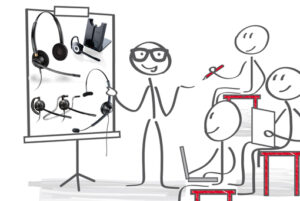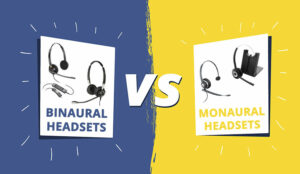We take a look at how headset technology is expected to change over the next few months and years.
What changes will we see in the next few months?
Headsets will know that they are being worn
The latest headsets are being fitted with sensors so that the system can recognise if they are being worn.
This will enable automatic updates to be transmitted to the system regarding an agent’s status, without them having to log in and do it manually.
For example, the system will automatically route an agent’s calls elsewhere if they remove their headset to handle a webchat conversation or take a toilet break.
Identifying cross-talking to detect stress or confrontation
Unified communications, the integration of real-time communications services, has helped to make homeworking a reality.
While this marks a step forward, it has brought a new set of challenges to the contact centre industry – mainly centring on “How do I manage agents I can’t see?”

Paul Dunne
In response to this, new developments in headset technology will focus on the ability to detect cross-talking in a conversation.
Cross-talking refers to moments when two people are speaking over each other, rather than passing back and forth, in a conversation. If more than 10% of a call contains cross-talking, it is usually an indication of an argument.
This feature will help contact centre managers identify agents who are stressed or require additional training – and maintain a strong focus on agent welfare.
With thanks to Paul Dunne at Plantronics
Noise-cancelling microphones can help improve customer satisfaction
With customer satisfaction an ever-greater focus, the industry has started to realise the benefits of using noise-cancelling microphones and, in very busy working environments, ultra noise-cancelling microphones.
These microphones remove the background noise, allowing the agent’s voice to be transmitted clearly, therefore leading to less repetition between customer and agent. This can result in quicker call resolution times and happier customers.
As the role of the contact centre agent evolves to become more of a specialist problem solver and brand ambassador, the need for noise-cancellation features will likely increase.
Active rather than passive noise cancellation
Another trend that is gaining momentum is active noise cancellation.
Rather than passive noise cancellation, which blocks out ambient background noise for the person on the other end of a call, active noise cancellation blocks out the background noise for the headset user.
The rise in active noise-cancelling headsets is being driven by knowledge workers who increasingly work in very noisy environments, in or out of the office, and need an audio device that helps them to build their concentration zone.
Homeworking will drive the need for good quality headsets
Contact centres will continue to move out of the office and into home or remote working environments in a bid to reduce overheads and use the collaboration tools that are now readily available.

Nigel Dunn
This will lead to remote agents working flexible hours to suit their lifestyles, outside of a team environment and away from their manager and other company departments.
This change in working practices will see the implementation of good quality multi-use headsets, rather than purchasing a low-quality, low-lifespan headset that only works with a desk phone.
It will also enable contact centres to fully adopt new technology and take advantage of trends such as Bring Your Own Device.
With thanks to Nigel Dunn at Jabra
What should we expect to see by 2025?
Gyroscopes and accelerometers will track agents’ head movements
Agent welfare will continue to be a key focus in the development of future headsets. As we near 2025, it is likely we will see headsets fitted with gyroscopes and accelerometers hitting the market.
These additional sensors will enable contact centre managers to monitor the head movements of their agents. This data can then be analysed to look for signs of tiredness (e.g. regular lolling of the head) or stress (e.g. throwing the head back suddenly).
With thanks to Paul Dunne at Plantronics
Intelligent headsets will help agents problem solve during a call
We could see the use of intelligent headsets within the contact centre by 2025.
They will provide knowledge to the agent wearing them, via apps developed for specific companies and their product or service portfolio.
The apps within the headset will be designed to aurally or visually support and enhance an agent’s knowledge – allowing them to problem solve in one call, without the need to transfer to a specialist or technician or call the customer back once their enquiry has been looked into.
This will empower agents to become specialist problem solvers.
The Internet of Things will help provide better customer service
The Internet of Things (IoT) will also be used to gather data, via the intelligent headset. This could then be used to provide better customer service, develop new products or further understand customers’ buying habits.
This will see the agent playing even more of a vital front-line role than they currently do – becoming an extension of an organisation’s marketing and sales departments.
With thanks to Nigel Dunn at Jabra
What do you think the headset of 2025 should be able to do?
Author: Megan Jones
Published On: 13th May 2015 - Last modified: 29th May 2024
Read more about - Technology, Future, Headsets, Homeworking, Jabra, Paul Dunne, Poly

















could there be something that improves the sound quality from mobile phones (reducing background noise from the callers end, removing wind sounds, feedback and so on)